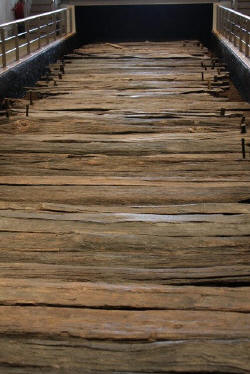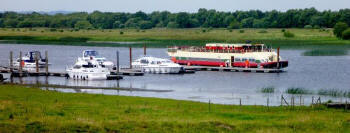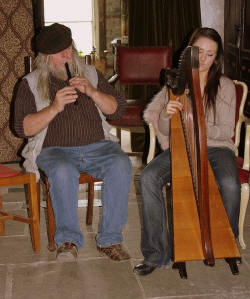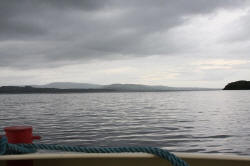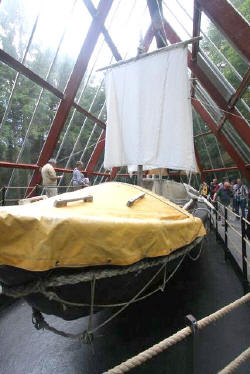 Shore
Trips from the Shannon Princess
Shore
Trips from the Shannon Princess
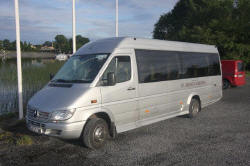
One of our favorite aspects of the small boat cruise is that generally the daily shore trips are included in the price of the cruise. The daily shore trips from the Shannon Princess were strong on heritage, culture, and natural history and light on shopping...which suited us just fine!!
Rich and I will generally include a road trip with a rental car as a second portion of a foreign visit. We will enjoy the cruise portion in the first week, the road trip during the second week... the shore trips while cruising provide us with a context for what we will see on our own... and the road trip reminds us how to take care of ourselves and travel independently in a foreign country!!
We discovered
that even as history buffs, we were surprisingly
uninformed about Ireland's long, long recorded history (6th century
monasteries dotted this wild land) of hunter-gatherers, clansmen, Viking
invaders, and English oppression. Olivia and Ruairi were both well informed
about the regional history of the Shannon River watershed. We appreciated their
distinctly Irish national interpretation. A comfortable new passenger van
with extensive windows provided air conditioned comfort and viewing.
-
As for our road trip photo album, please click here... our #1 tip for road tripping in Ireland? Be certain to pick up a GPS with your auto rental. And we would really suggest "0" liability insurance if you hope to alleviate stress while maneuvering the sometimes narrow and meandering country roads.
LOUGH REE & WESTMEATH. Itinerary for Regular Cruise – south bound to Killaloe.
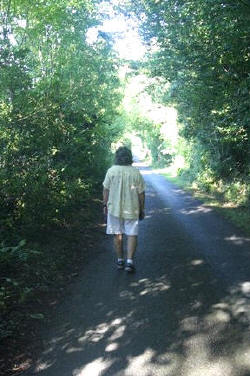 DAY
1... Ruairi met us promptly at 3 p.m. at the Aberdeen Lodge and wasted no time in getting us out to some "classic" Ireland.
LOUGH REE and the
marina at WESTMEATH
was about a two hour drive
east from Dublin, in Ruairi’s new passenger van.
DAY
1... Ruairi met us promptly at 3 p.m. at the Aberdeen Lodge and wasted no time in getting us out to some "classic" Ireland.
LOUGH REE and the
marina at WESTMEATH
was about a two hour drive
east from Dublin, in Ruairi’s new passenger van.
We used the two hours to get our first view of Ireland, with Ruairi fielding our questions right and left. We met Chuck and Ann, our shipmates and table partners for the coming week.
We had our first greatly anticipated gourmet dinner on board the Shannon Princess. Our well-traveled fellow passengers had no idea of this special aspect of the cruise... they were were incredulous.
Rich's reaction to his first gourmet cruise...
"Pat, I'm humbled by this experience!"
DAY 2: Cruising the Shannon River, Athlone and the “Corlea Trackway Visitor Centre” and Bog.
Each morning, there was time before breakfast for me to get out and walk an Irish country road... some of my favorite moments of the whole excursion!
Olivia encouraged me to return for the specific Walking/Cruise itinerary. Ireland is criss-crossed with ancient "pilgrim trails" and narrow country roads. In addition to dedicated walking cruise, other cruise itineraries may be organized to focus on golf, horse-back riding, etc.

After breakfast, we boarded the "silver bullet," Ruairi's new passenger van, to visit a nationally preserved peat bog and interpretive center. There, we learned about the peat which has provided the Irish with fuel since ancient times, and we learned about the Corlea Trackway. The heritage site interprets some of the many local archaeological finds from Pagan Celtic Ireland discovered in the bog, including an Iron Age wooden plank road which crossed the bog for perhaps ten years in the vicinity of 148 BC.
Once again, how pleased I was to have seen the peat-preserved men at the National Archeological Museum!!! Our enthusiastic guide explained in detail theories about who these individuals were and why they may have been discarded into the bogs. She also troubled herself to go "off-trail" to show us sundew, heather, and pitcher plants growing in the bog.
Ruairi, in turn, pointed out a utility plant powered only with native peat, and pointed out private peat fields where bricks of peat were drying whenever we happened to pass one of them.
Our harbor was in Athlone, and we had plenty of time to explore the town and
look for musicians in the pubs. Pubs are family gathering places in Ireland, and
on one occasion, the musicians were 3 young teenagers, perhaps 12-14 years old!
The pub was filled with extended family to cheer them on!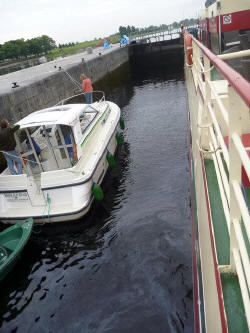
Day 3... Athlone lock, the ruins of Clonmacnoise Abby, a "pilgrim road," Celtic Crosses and inscribed stones..
Any Mississippi River buff is
well acquainted with our 26 locks. On the Shannon River, there are two, and our
first was the Athlone lock. It was substantially the same as any we might see on the
Upper Mississippi River, but it is always adds a little sense of adventure to a
cruise. Here, we locked through with a rental yacht.
I take a special interest in the march of
Christianity across Europe... as with noticing the birds and plant life around
the world, it's a way for me to make connections in our travels. A local resident during our journey described
ancient Ireland as a sort of "spa for monks." Looking for solitude? Looking to
trust God against the elements? Looking to purify yourself in the face of a
particularly uncomfortable climate? In the face of rocks, grey rocks, grey sky
and grey sea? IRELAND was the place for Monks to go!!!
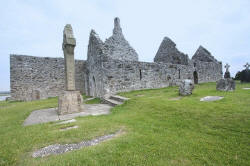
Clonmacnoise Abby, located at a narrow spot in the Shannon River right along a high glacial esker or moraine may have been connected to the ancient burial grounds of High Kings of Tara and Connaught. The community of monks established here in the 6th century eventually grew into a major crossing point in the heart of Ireland. Vikings sailed up from the mouth of the Shannon to sack the Abby, Irish clansman attacked many dozens of times, but the monks persisted in protecting their documents, and keeping daily journals.
At Corlea Trackway, a daily entry was displayed from one of these journals as an example of what it must have looked like when the Corlea Trackway was being constructed (or a bridge over the Shannon here at Clonmacnoise)... "It looked as if all the men in the world had gathered here" to haul, split, and put in place the ancient oak planks. Our harbor was in Shannonbridge.
Day 4.... Leap Castle and celtic harp and flute, a memorable excursion to Leap Castle, once the stronghold of the Princes of Ely, and reputed to be Ireland’s most haunted castle. We enjoyed a friendly visit with the owner, Sean Ryan and his daughter, who has traveled much of the world with an Irish dance troup. She also performs on the Irish Harp. Sean plays the flute. So we enjoyed greatly hearing and watching them perform together!
Birr Castle and the telescope built in 1840s, largest in world for 70 years, and its historic castle gardens. The Castle is home to Ireland’s Historic Science Centre.
Lough Derg (pronounced "lock") refers to a "lake" area where the Shannon River has been constricted, much like Lake Pepin on the Mississippi River.
"The Shannon Princess follows the river's gentle curves, passing crumbling ivy covered ruins, medieval garrisons & sleepy market villages. Onwards we head, in the wake of time, floating by dappled woodlands & floodplain meadows. The ever-changing landscape slipping by, descending through Meelick lock and pausing as Portumna Swing Bridge is opened to allow the Shannon Princess onto idyllic Lough Derg. " -- Shannon Princess website, www.shannonprincess.com
We moor waterside at the foot of a gentle hill that slopes up to Terryglass village where we enjoyed viewing the historic barge regatta.
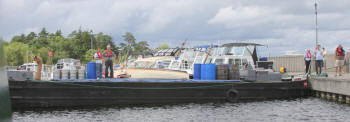 Here is a Guinness barge from about 1910.
Here is a Guinness barge from about 1910.

Day 5... Galway Van trip, Pub lunches, shopping, and lunch at an authentic Guiness and Oyster bar
En route, Ruairi pointed out that the stone walls of In County Galway, some 250,000 miles of them (!) had been constructed as government work projects during the Potato Famine of the late 1840s. They were also totally pointless... they did not define property lines, or county lines, or fields. They simply put the poor to work.

Our shore trips thoughtfully included "shore lunches" in some of the storied Irish pubs!
Day 6: Craganowen Living Past (living history displays of the early millennium... Irish monks and the Voyage of the Brennan to America, Fortified villages, life in a square tower, Irish boars. Also the 16th century Portumna Castle...
We learned at Portumna Castle of the architect's progression from round tower,
to square tower, and then the connecting of four square towers
to form a castle mansion, or "great house." We also learned that the terms and
practices used in America's deep South were long in
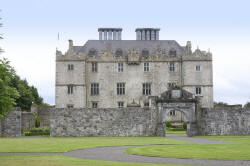 operation
in Ireland!! "Plantations" indicated British citizens "planted" in a
foreign locale for the purpose of exploiting the natives and resources of that
country. In the case of Ireland, entire English villages were planted throughout
Ireland. These would hold the country for the English crown. The villagers and
the Irish both served at the will of the English Lords, many of whom never
actually lived in their castles.
operation
in Ireland!! "Plantations" indicated British citizens "planted" in a
foreign locale for the purpose of exploiting the natives and resources of that
country. In the case of Ireland, entire English villages were planted throughout
Ireland. These would hold the country for the English crown. The villagers and
the Irish both served at the will of the English Lords, many of whom never
actually lived in their castles.
We also
learned that during the Potato Famine, only the Irish starved. As "serfs"
of the English landlords, they worked the rich fields, and cared for the fat
cattle and horses, but were allowed only to eat potatoes they raised on their
small home sites. Picking an apple from the English landlord's property carried
a death sentence.
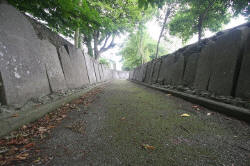
When the potato blight struck, agricultural products continue to flow to England as the Irish starved to death. Eventually a million Irish died of starvation or disease, and a million more emigrated to America, Australia, England, and other foreign countries. The Irish population was reduced by half.
Gravestones line a quiet walkway on the grounds of a "Famine Warehouse" where the starving poor were housed by the English government.
Brennan Hide Boat at Craganowen Living Past.
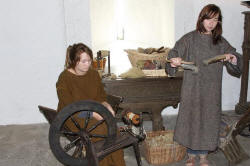 Living history in a
fortified square house.
Living history in a
fortified square house.
At Craganowen Living Past we enjoyed living history displays of many historic structures, and again I was grateful for my visit to the Archaeological Museum in Dublin. Here we walked in the reconstructed thatched huts of ancient farmers fortified on a man-made island. We saw a huge outdoor cooking pit, tiny fenced fields, even some wild boars. But for me, the most interesting item was a hide boat, which actually followed the route of Father Brennan to the Northeast coast of North America in the 6th century. Brennan was only one of many monks believed to have followed a route from Ireland to modern Greenland and northeast Canada and America. Long before Columbus ever set sail from Spain.
Saturday, day 7 ...Killaloe / Dublin.
We returned to Dublin (where our tour ends), arriving at approximately between 11: 30 a.m. and 12:00 noon. Normally, the passengers return "home" to the Aberdeen Lodge. On this occasion, all four passengers were returned to the airport area where our travel-mates were staying at a hotel and we hopped off to pick up our car rental.
Suddenly, we were on our own!!!
PHOTO ALBUMS
Click for specific Album
Cruising on the Shannon River,
Shore Trips,
Arriving Dublin,
Irish Road Trip
Return to our Travel/Waterway Insight Features at www.greatriver.com/waterwaycruises/

